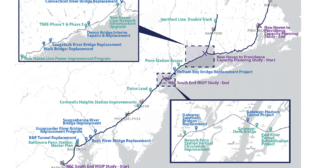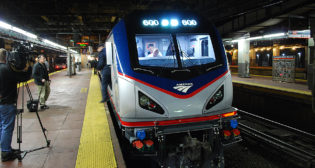
Ties That Bind
Written by Andrew CorselliRAILWAY AGE, MARCH 2020 ISSUE: Transferring loads to track ballast and subgrade and helping maintain track geometry and gauge, crossties are the foundation of a railroad.
Crossties come in many forms, with wood being the most prevalent. Concrete ties are the standard for high-performance rail and select heavy-haul freight applications. Steel and composite have been making inroads in recent years, for specialized applications.
The Railway Tie Association (RTA), which in 2019 marked its centennial, describes itself as “the forum for the interests and needs of all groups that depend on the wood crosstie for their business success.” RTA’s Procurement Trends Dashboard, offered on its website, “represents the monthly opinions of ‘in-the field’ wood tie buyers who procure untreated crossties from sawmills in their specific regions.” The data is submitted to RTA within the first two weeks of the month following the reporting period. The output is in two forms: monthly and a 12-month running view. Users can choose individual regions or grouped regions from the dropdown menus for monthly and trend data.
Koppers has been serving the railroad industry with treated wood railroad ties and railroad crossing panel products for more than 25 years. “In North America, we are the largest provider of railroad crossties for Class I’s and are known for our pre-plated crossties,” the company noted. “With nine wood treatment plants located on major rail lines throughout the United States and Canada, Koppers is uniquely positioned to meet the demands of Class I and short line railroads and railroad contractors. Our nationwide tie procurement network means crossties and switch ties are readily available to quickly meet customer needs. We maintain a network of 30 hardwood crosstie concentration yards. Untreated crossties and switch ties from these procurement centers are delivered as needed to Koppers wood-treating plants. These plants produce high-quality creosote-treated crossties and switch ties, combining industry-standard treatment with strategic location to provide reliability and maximum efficiency.”
Wood ties, which depending upon application can last 25 or more years in service, require preservatives and pressure treatment. There are various treatment methods and chemicals. In recent years, environmental considerations have taken on increasing importance.
Nisus Corp. manufactures several crosstie preservatives, Ken Laughlin, Vice President Wood Preservation Division, told Railway Age. Cellutreat—a Disodium Octaborate Tetrahydrate wood preservative available in a 98% water-soluble powder and a 50% liquid concentrate—is “Nisus’s biggest seller,” he said. “Fifty percent of the ties in North America are dual-treated with a borate, which is basically our Cellutreat product.”
Nisus’s second-best seller is QNAP, described as “an environmentally friendly copper naphthenate product.” Laughlin estimated that Nisus “presently has more than four million ties treated with QNAP in-track in North America.” Also popular is Nisus’s BTX Bridge Tie Extender. “We’ve got just about every Class I railroad switching over to copper naphthenate for bridge ties,” Laughlin noted. BTX has also caught on with Class II and III railroads, many of which are upgrading older bridges to handle 286K GRL railcars.
QNAP2—a 2% oil-borne preservative—rounds out Nisus’ lineup, but for a different application. “Ties are not treated with QNAP2,” said Jim Gorman, Corporate Vice President Marketing. “But when you cut a tie, you’re exposing wood that’s not pressure-treated. QNAP2 is applied to a cut or a drill hole, so that you’re not exposing the tie.”
Nisus ventured into the crosstie space via an unconventional path. “We were a pest management company first,” Laughlin said. “When there were three manufacturers of copper naphthenate, all three decided they were going to stop selling it because the U.S. EPA (Environmental Protection Agency) did a data call that was going to cost them about $3 million each. Some people from the wood preservation industry contacted us. They said, ‘You know, this is a great chemical and we’re going to lose it if somebody doesn’t pick up the registrations.’ I met with EPA, and we were able to get a copper naphthenate registration in just six weeks so that we could start selling it. Once that happened, we went into the wood preservation business.”
In addition to the tried-and-true tie mainstays, non-traditional materials like composites, plastics and steel—which suppliers say offer low lifecycle costs—are increasing in use.
“It was more than 20 years ago,” said Linda Thomas, President, LT Resources Inc., of her first foray into composite materials. “One of my customers had some inconsistency issues with timber grade crossings. So we started looking into something different and began manufacturing composite grade crossings in 1998. It made sense to put a composite tie into a crossing. We got involved with the composite tie industry and AREMA Committee 30, developed standards and worked through the acceptance process. Composite ties are environmentally friendly, last longer and don’t have the disposal issues that you have with treated wood.”
Conrail turned to NARSTCO (a division of RailWorks) steel turnouts for its lower installation costs, reduced maintenance needs and longer in-service life, according to Assistant Vice President Engineering and Mechanical Eric Levin. “With proper surface maintenance, these steel ties can withstand the heaviest traffic areas. Conrail has had measurable success in every location NARSTCO steel ties have been installed.”
“We’re seeing a greater increase in the use of steel ties throughout the rail industry,” said NARSTCO Senior Director of Sales and Marketing Matt Violin. “Steel is easier, faster and less expensive to install and maintain, lasts longer than other materials, and helps improve operational efficiency.” Steel ties, he noted, are recyclable and call for less ballast–up to 40% less compared to wood ties—and can last longer, as evidenced by ties installed more than 50 years ago that are still in service.
For Conrail, the adoption of steel continues as existing wood ties and turnouts are replaced. Conrail’s Stoney Creek Yard in Chester, Pa., required replacement of custom aging wood turnouts. Upon receipt of site surveys and field measurements, NARSTCO’s engineering team designed four custom steel turnout sets matching the existing infrastructure. For Conrail’s Mound Road Yard in Detroit, a similar procedure was followed, where two custom turnouts “provided a high-quality installation without the necessity of field modifications or additional installation time.” Three steel turnouts will also be installed at Conrail’s Doremus Yard in the Philadelphia area. NARSTCO is providing on-site support for crews constructing these materials at Norfolk Southern’s Roanoke Turnout Panel Facility.
Machinery For Removal, Replacement and Inspection
Several companies provide tie replacement equipment to railroads. Progress Rail, for example, manufactures Kershaw® maintenance-of-way machines for sale to Class I, II and III freight railroads, transit agencies and contractors around the world. Among its equipment is the Kershaw® 12-12 Bridge Crane, which is designed to perform bridge and open-deck trestle work, and the Kershaw® Model 47-6 Tie Replacer, which can remove or insert wood or concrete ties up to 18 feet long.
Harsco Rail describes its TKO® Tie Exchanger as “executing fast, efficient used tie removal and proper insertion of new ties with minimum disturbance of the track structure. The TKO® focuses on controlling rail-to-tie clearance with its distinctive rail life system. Its two clamp/lift units are located on four-foot centers. Articulated gripper heads are able to pivot up to 40 degrees.” Performance-wise, this machine offers an extracting force of up to 20,700 pounds, a tie kicker with up to 10,000 pounds of force to push the end of the tie being removed, an inserting force of up to 13,550 pounds, and a 66-inch tie removal stroke, with the extracting head located on the right side of the machine.
Harsco’s TR-10 Production Tie Exchanger is equipped with an extracting head on both sides, and a swivel head that provides adjustment of the tie position, “allowing easy insertion or extraction.” With an extracting force of up to 19,080 pounds and an inserting force of up to 13,550 pounds, the TR-10 “handles switch ties with ease.”
Encore Rail Systems, Inc. is a full-service company. Greg Spilker, Vice President and General Manager, told Railway Age that Encore has more than 100 machines in its lease fleet. “We supply the machines with field support,” he said. “We have the parts and technical help, and a field service team in North America for repairing, training and assisting customers with their equipment needs.”
Spilker added that Encore recently celebrated a safety milestone. “We’ve gone three years without a lost-time injury, and working in the environment we are, we’re very proud of that. It’s something we focus on quite a bit.”
Some railroads develop and deploy their own specialized equipment. Union Pacific, which annually replaces between 3 and 4 million ties across its 32,000-plus route-mile, 23-state system, has designed and built, with a supplier it declined to disclose, high-tech equipment to expedite the tie removal process. UP’s Maintenance of Way Tie Pickup Work Equipment has two excavators that ride along the top of a series of connected 70-foot-long railcars. Operators in the excavators pick up tie bundles left in stacks along the right-of-way. Once the railcars are fully loaded, the train departs directly to one of three facilities where ties are recycled or shredded for cogeneration fuel. (Used ties are not offered to the general public for reuse.)
Each railcar holds 500-700 ties, which is about the same number it can pick up in an hour. The new system doubles the number of railroad ties that can be disposed of per day, to nearly 5,000. UP said it plans to add more of these machines over the next 15 months.
GREX’s Aurora technology is a major tie-inspection venue for Class I’s. Its combined machine vision and X-Ray technologies allow for a thorough inspection of crossties in-track. “This provides railroads with a data-driven strategy for planning the replacement of these assets as they approach end of life expectancy,” said Nate Bachman, GREX Vice President Marketing and Sales.
Industry Direction
George Caric, Vice President Marketing, Stella-Jones Corp., told Railway Age that—unlike last year at this time—“we’re seeing tie inventories pick up; the demand for crossties is strong.” Caric concedes, though, that Mother Nature could put the kibosh on that.
“We need it to stop raining,” he said. “Alabama and the South are experiencing torrential downpours and flooding. We need it to dry up. We’re coming out of winter with a semi-good log pile. Hopefully we’ll be able to ride this out and get our inventories back where they need to be.”
Despite that, Caric said, “We’re in a much better position than we were last year. Pricing was rising due to outside influences—China exports and wet weather all had an effect on crosstie production. There’s a consistent demand for ties, and the sawmills know that the railroads are going to buy 21-22 million a year—and that’s year-over-year. That’s helping the sawmills now because the markets for the boards and the side lumber are not as lucrative as they were 18-24 months ago.”
Encore’s Spilker noted that he thinks 2020 is going to be a good year. “It should be an up year compared to 2019 as far as new rail installation,” he said. He added that Encore has several new crosstie-related products it’s looking to introduce this year. Nisus Corp.’s Laughlin agreed that “prices and availability are pretty much stabilized.”
Bachman noted that “2019 was an excellent year for GREX. In fact, it was the best in the company’s history. We feel good about what 2020 holds. I anticipate that it will be another growth year for GREX, with the potential to be even more than that. We are working with partners to develop the next generation of inspection imaging hardware. The system will be available for field testing in 2020 with the future capability to see the entire field of view of track at maximum speed. Our expectation is this new technology will allow for the enhancement of existing GREX inspection technologies as well as the development of new solutions.”
The transit side, too, seems to be tying things together very nicely. Vince Petersen, Engineering Manager, CXT® Inc./L.B. Foster, is encouraged by positive developments in the transit segment expanding the use of the company’s concrete ties. CXT has secured contracts for special trackwork concrete turnout ties for projects in Ottawa and Calgary from London Trackwork, Inc., an Ontario-based supplier of railway track materials.
“Canadian transit infrastructure spending continues to perform well on both the East and West Coasts,” Petersen said. “We expect that to continue for the next few years, especially in Ottawa, Calgary and Edmonton.”



